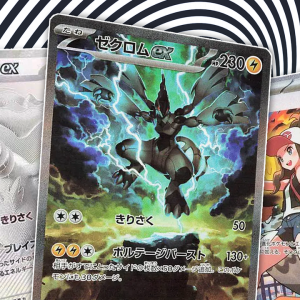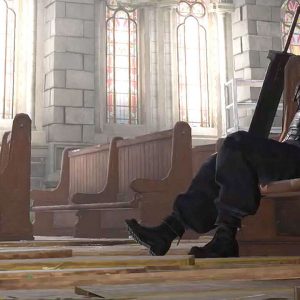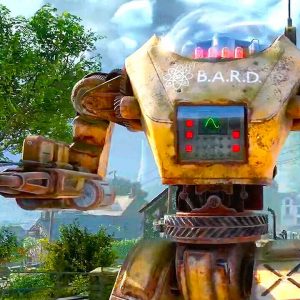I’m not exactly sure why a developer best known for quiet, choice-filled games that border on interactive movies is so interested in turning them into arcade-style rail shooters, but Supermassive Games is taking another crack at exactly that – this time with the help of the new PlayStation VR2 headset. Like Until Dawn: Rush of Blood before it, The Dark Pictures: Switchback VR focuses less on storytelling and more on action to mixed results. While it’s fun to blast through ghouls and bats in my path, this spinoff is plagued by many of the same issues as its predecessor, including a disappointingly short runtime.
Switchback VR’s story feels like an afterthought, putting you in the role of an unnamed protagonist on a hellish rollercoaster ride across ten different stages. Most are locations featured in the first season of The Dark Pictures Anthology, but you’re never really told much about why the protagonist is visiting them or any of the few supporting characters they meet. That’s partially because Switchback VR is very short, only taking me about four hours to complete, but it’s disappointing all the same, given how good of a job Supermassive usually does providing backstory and depth to its characters.
But what it lacks in story, Switchback VR mostly makes up for in gameplay. While the on-rails nature of its action naturally limits where you can go, you are able to move your head to look around in any direction in VR. It was fun to quickly turn each time I heard eerie screams or enemies creeping up on me in the background or occasionally having to physically duck to avoid falling beams and leaning pillars. That situational awareness is key as enemies will sometimes sneakily appear to the left and right of your peripheral vision.
You will always have two guns to fend off enemies, each independently controlled with the PS VR2’s Sense controllers. While you start every level with the default pistols, you can grab ammo-limited alternatives like a revolver or a machine gun by shooting red crates that appear in convenient sections of each stage. It’s annoying that these special weapons are locked into the hand you initially shot the crate with, but you can still have some fun switching up your strategy for a bit when you find them. For example, you could use a machine gun to swiftly remove enemies close to your cart and conserve ammo by firing the pistol at enemies further away. Other weapons like a flare gun are required to solve certain puzzles and progress further – they do not require a lot of thought to solve, as you just need to shoot at certain objects to keep the track moving forward, but it is a nice change of pace from just shooting hordes of enemies.
“
The shooting mechanics themselves have been simplified for VR, with firing and reloading both mapped to two buttons on each Sense controller since so few are needed overall. That’s not a bad thing as on-rail shooters focus more on throwing as many enemies at you as possible in a short period of time than nuanced gunplay. Still, shooting in Switchback VR feels responsive and the motion-controlled aiming is very accurate, which made headshots extremely rewarding each time I pulled one off.
The heads you’ll be popping vary depending on the stage you’re on, ranging from standard zombies to flying vampires. Most of these enemies will be familiar to those that played any of the first season of The Dark Pictures Anthology, each a faithful recreation of the monsters from those games. Killing enemies or destroying inanimate objects such as bottles, empty crates, and skulls will increase your score for a level, which is a nice incentive to deal as much damage as you can. There are even local and online leaderboards for you to compare scores with other players, but it feels like a shallow exercise when they don’t measure important factors like accuracy.
Switchback VR nails the creepy atmosphere and tension of each stage – from the dark and abandoned World War 2 freighter seen in Man of Medan to the sandy underground ruins of the ancient empire featured in House of Ashes. Unfortunately, the frequent overuse of cheap jump scares quickly overshadows any building suspense provided by a given location. While the first two enjoyably caught me by surprise, it doesn’t take long for them to become more annoying than alarming.
But while the jumpscares did little to keep me on the edge of my seat, the handful of sections where Switchback VR took advantage of the PS VR2’s eye-tracking were actually impressively unsettling. These areas have enemies that move closer and closer to you each time you blink, which is an incredibly novel experience for any game that left me wanting to see more. It’s a shame that only a few moments of Switchback VR make use of this concept, but the parts that do are a great showcase of the potential of this new tech in future horror games made for the headset.
“
Although Supermassive has done a good job of including some of the PS VR2’s new technology, Switchback VR still feels a bit technologically unpolished in a few places. I noticed a few performance issues while playing: Some background textures, like tree branches, would randomly appear as the cart moved closer to them, and I had three instances where the screen froze for a few seconds. These issues were relatively minor and didn’t totally throw my ride off the rails, but they were still noticeable and annoying on such a brief trip.
Despite its short length, Switchback VR does offer some replayability by letting you go down different routes that help shake up each run. Most of these decisions are made by shooting at specific gates that allow you to change your cart’s course, which is a nice way to blend that choice into the action. You even get a complete view of your route at the end of each stage, along with a tease of the alternate paths you could have taken, encouraging me to go back in and see what I missed. That said, the little bit of variety those routes offer isn’t very memorable when you can still see everything Switchback VR has to offer in two or three playthroughs.
In addition to changing your route, some stages give you an option to save, kill, or abandon survivors that appear in some stages. Each survivor is tied to an optional puzzle that gives you amount of time to at objects in a specific order. However, like most of Supermassive’s games, the majority of these small decision points have little or no impact on the overall story.
Boss fights are also included at the end of some stages, but their execution leaves a lot to be desired. These battles pit you against antagonists from their respective Dark Pictures entries, such as the final form of the Sailor Girl in Man of Medan, whose boss battle consists of her levitating and throwing projectiles at you. Most of the boss fights end up boring and unremarkable, like busy work to slow you down rather than an epic obstacle you must overcome to finish the stage.
























